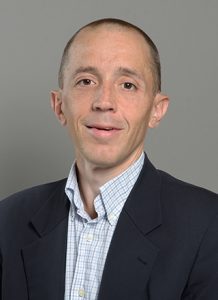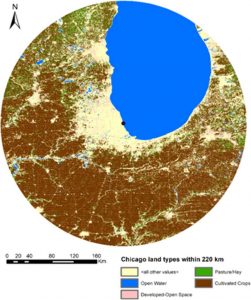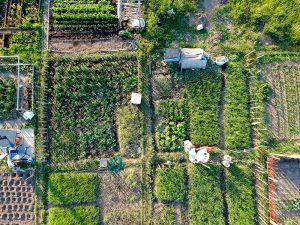April 27, 2021

 The team used geographic information systems (GIS) data to determine the amount and the type of land available for farming. Yield information was obtained from USDA, giving the square meters of farmland needed to produce one kilogram of each crop, at the county level. These yield data were modeled two ways, based on ten-year historical averages, and also accounting for the variability that existed over the ten-year period.
“First, we found that there was no way to meet some nutritional requirements, like vitamin D, using conventional methods with no vitamin fortifications,” McGarvey said. “Allowing for current levels of vitamin D fortification in milk and other foods, our minimum radius needed was 185-220 kilometers (115-137 miles) from Navy Pier, depending on yield assumptions.”
The research next considered adding urban agriculture, such as using empty city lots for growing food. To determine yield amounts that could be grown in an urban environment, the team turned to the Columbia Center for Urban Agriculture (CCUA) for assistance. “They gave us a lot of data,” McGarvey said. “So, when we talk about how much could be produced on open urban land in our paper, those findings came from partnering with CCUA and the urban lots they have throughout Columbia.”
The team used geographic information systems (GIS) data to determine the amount and the type of land available for farming. Yield information was obtained from USDA, giving the square meters of farmland needed to produce one kilogram of each crop, at the county level. These yield data were modeled two ways, based on ten-year historical averages, and also accounting for the variability that existed over the ten-year period.
“First, we found that there was no way to meet some nutritional requirements, like vitamin D, using conventional methods with no vitamin fortifications,” McGarvey said. “Allowing for current levels of vitamin D fortification in milk and other foods, our minimum radius needed was 185-220 kilometers (115-137 miles) from Navy Pier, depending on yield assumptions.”
The research next considered adding urban agriculture, such as using empty city lots for growing food. To determine yield amounts that could be grown in an urban environment, the team turned to the Columbia Center for Urban Agriculture (CCUA) for assistance. “They gave us a lot of data,” McGarvey said. “So, when we talk about how much could be produced on open urban land in our paper, those findings came from partnering with CCUA and the urban lots they have throughout Columbia.”
